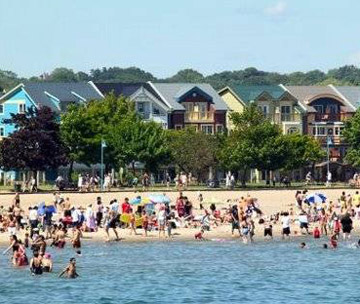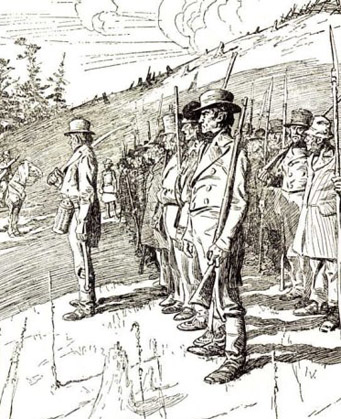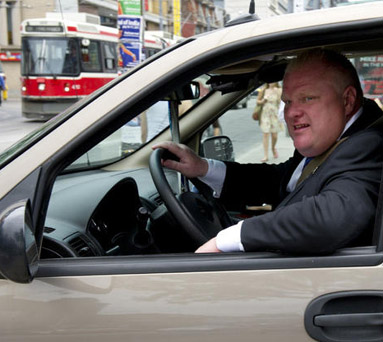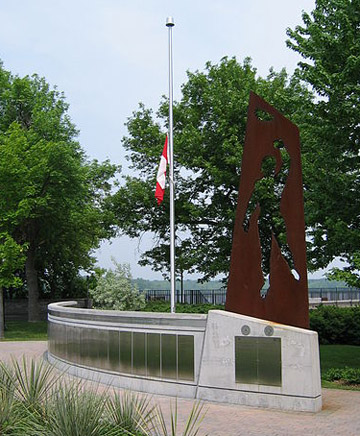Summer in the city 2012 .. winking at Rob Ford .. and remembering various anniversaries of Mackenzie-Papineau
Jul 14th, 2012 | By Citizen X | Category: In BriefTORONTO. SATURDAY, JULY 14, 2012. This may not be the greatest city in Canada, whatever that may mean. But it sure is hot here today. I have nonetheless been asked to devote at least part of this sunny afternoon to informing all who may be interested that the relevant staff have now completed their latest update of the Streetcar Named Rob Ford page, entitled “Friday 13 July 2012 : Rob Ford’s Toronto city council rides off into sunset for rest of summer.”
Meanwhile, some further public service announcements flow from various anniversaries associated with the turbulent political career of the first Mayor of the City of Toronto, William Lyon Mackenzie (1795—1861). To start with, the skilled photographer and videographer Agnes Cseke has now put the finishing touches to her film of the April 12, 2012 commemoration of the Toronto public hangings of Samuel Lount and Peter Matthews 174 years ago, for their roles in Mackenzie’s ill-fated Upper Canada Rebellion of 1837 – which helped lay the groundwork for the Canadian democracy we enjoy today.
As noted in counterweights this past April 9, this commemoration – or more aptly this austere but moving vigil – was organized by the Lount and Matthews Commemoration Committee (Ashok Charles, chair ; Wayne Adam ; Tony O’Donohue ; and Randall White).
 Like the event being commemorated, it began early in the morning (in this case at 7:30 AM), and did not attract anything like the crowd of 10,000 who are said to have witnessed the sad hangings of Lount and Matthews in 1838. As Ashok Charles has stressed, this was just the beginning of an annual event meant to make this important event in the city’s history much better known in the 21st century. And the small but resolute band who were present made a strong beginning. Not everyone may want to watch the full 30 minutes of Agnes Cseke’s fine film. But if you have any interest at all in any aspect of the subject, it’s well worth dipping into – at a city venue that now lies just across the street from Conrad Black’s old Toronto head office!
Like the event being commemorated, it began early in the morning (in this case at 7:30 AM), and did not attract anything like the crowd of 10,000 who are said to have witnessed the sad hangings of Lount and Matthews in 1838. As Ashok Charles has stressed, this was just the beginning of an annual event meant to make this important event in the city’s history much better known in the 21st century. And the small but resolute band who were present made a strong beginning. Not everyone may want to watch the full 30 minutes of Agnes Cseke’s fine film. But if you have any interest at all in any aspect of the subject, it’s well worth dipping into – at a city venue that now lies just across the street from Conrad Black’s old Toronto head office!
* * * *

C.W. Jefferys’ early 20th century drawing of Rebels Drilling in North York, Summer 1837. Historians today tell us: “Between late July and the end of October only one military training session was held north of Toronto.”
Agnes Cseke has recently posted on You Tube another shorter film that captures some of the excitement surrounding another recent event reported in counterweights – this time on this past June 22 (“Last days of British empire in Argentina .. and Canada too? / Charles Roach’s ‘Freedom Five’ move ahead with Canadian citizenship oath court case”). You can view her work here by clicking on “Charles Roach’s Anti-Monarchy Oath Case.”
As it happens, the summer of 2012 also marks the 150th anniversary of the summer of 1837, when Upper Canada Rebellion leader William Lyon Mackenzie and his associates were “organizing committees of vigilance and political unions” in Toronto. During “August and September” they “carried the message of Toronto Reformers to a series of meetings in the Home District … Resolutions were passed expressing extreme concern over the present state of the colony [of Upper Canada – present-day Ontario] and calling for a convention of delegates from the various townships and from Lower Canada [present-day Quebec] to discuss remedies. Probably Mackenzie himself had much to do with the wording of many resolutions, a few of which vaguely suggested a resort to force.” Yet “there is evidence that he was ambivalent on the subject or even completely opposed to an armed rising … Between late July and the end of October only one military training session was held north of Toronto.” The ill-fated and restrained armed risings that finally did take place would not happen until early December.
Meanwhile, in what is now Quebec Louis Joseph Papineau, “known as a inspiring orator … participated in many of the meetings held by the patriotes during the summer of 1837. However, he always advised against taking extreme action and sought to achieve political and social change through the law courts and the parliament. He also supported non-violent actions such as a boycott against British goods. Papineau later claimed that the government provoked an armed revolt as a means to discredit and crush the patriote opposition.”
Finally the month of July 2012 marks the 75th anniversary of the creation of the Mackenzie—Papineau Battalion during July of 1937, to give Canadians fighting with the International Brigade in the anti-fascist Spanish Civil War some national recognition (even though the Government of Canada was at the time definitely not in favour of this activity). If all this is news to you, probably the best short account on the world wide web at the moment is by Myron Momryk, a historian with the National Archives of Canada. And, in a perhaps vain attempt to suggest that in Toronto we sometimes do try to look all around our Canadian free and democratic society today, I’ll just quickly note by way of conclusion that there are now happily two monuments commemorating the brave Canadians who fought as members of the Mackenzie—Papineau Battalion in the Spanish Civil War – one in Victoria, BC and the other in the Canadian capital city of Ottawa. We no doubt ought to have such a monument in Toronto too – along with an annual commemoration of the sad hangings of Lount and Matthews, who fought for Canadian democracy in the Upper Canada Rebellion of 1837.



